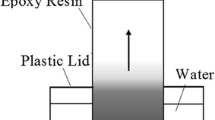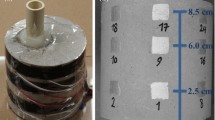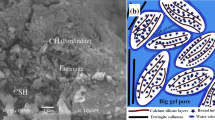Abstract
1D Centric Scan SPRITE magnetic resonance imaging measurements were undertaken to observe the water content distribution in 10 cm length mortar specimens with a steady state water content due to wicking and evaporation. Results show bi-exponential behavior of the magnetic resonance signal lifetime \(T_{2}^{*}\) in all samples, indicating at least two different water populations. The short \(T_{2}^{*}\) lifetime, related to interlayer water, and its associated amplitude are constant along the sample. The long \(T_{2}^{*}\) lifetime, related to water in the pore space, and its associated amplitude, change with local moisture content. In the steady state the wet front was displaced deeper into the sample as the water to cement ratio increased. The transport parameters controlling the wicking and drying were extracted by fitting the experimental profiles to two literature models. In both cases the transport parameter values increase as the water to cement ratio increases.








Similar content being viewed by others
References
Lockington D, Parlange J-Y, Dux P (1999) Sorptivity and the estimation of water penetration into unsaturated concrete. Mater Struct 32:342–347. doi:10.1007/BF02479625
Neville AM (1995) Properties of concrete, 4th edn. Longman Group Limited, Harlow Essex
Hall C (1989) Water sorptivity of mortars and concretes: a review. Mag Concr Res 41:51–61. doi:10.1680/macr.1989.41.147.51
Buenfeld NR, Shurafa-Daoudi M-T, McLoughlin IM (1995) Chloride transport due to wick action in concrete. In: 1st RILEM work. Chloride Penetration into Concr. St Remy les Chevreuse, France, pp 315–324
Puyate YT, Lawrence CJ (2000) Steady state solutions for chloride distribution due to wick action in concrete. Chem Eng Sci 55:3329–3334. doi:10.1016/S0009-2509(99)00566-7
Puyate YT, Lawrence CJ (1999) Effect of solute parameters on wick action in concrete. Chem Eng Sci 54:4257–4265. doi:10.1016/S0009-2509(99)00158-X
Baroghel-Bouny V, Thiery M, Wang X (2011) Modelling of isothermal coupled moisture-ion transport in cementitious materials. Cem Concr Res 41:828–841. doi:10.1016/j.cemconres.2011.04.001
Carpenter TA, Davies ES, Hall C et al (1993) Capillary water migration in rock: process and material properties examined by NMR imaging. Mater Struct 26:286–292. doi:10.1007/BF02472950
Pel L, Hazrati K, Kopinga K, Marchand J (1998) Water absorption in mortar determined by NMR. Magn Reson Imaging 16:525–528. doi:10.1016/S0730-725X(98)00061-7
ASTM C1585-13 (2013) Standard test method for measurement of rate of absorption of water by hydraulic cement concretes, West Conshohocken, PA
Fischer N, Haerdtl R, McDonald PJ (2015) Is colour change a good measure of a water penetration front? Mag Concr Res 67:1048–1053. doi:10.1680/macr.14.00354
Selih J, Sousa ACM, Bremner TW (1996) Moisture transport in initially fully saturated concrete during drying. Transp Porous Media 24:81–106. doi:10.1007/BF00175604
Bohris AJ, Goerke U, McDonald PJ et al (1998) A broad line NMR and MRI study of water and water transport in portland cement pastes. Magn Reson Imaging 16:455–461. doi:10.1016/S0730-725X(98)00072-1
Chen Q, Halse M, Balcom BJ (2005) Centric scan SPRITE for spin density imaging of short relaxation time porous materials. Magn Reson Imaging 23:263–266. doi:10.1016/j.mri.2004.11.020
Beyea SD, Balcom BJ, Bremner TW et al (1998) Magnetic resonance imaging and moisture content profiles of drying concrete. Cem Concr Res 28:453–463. doi:10.1016/S0008-8846(98)00009-X
Halse M, Goodyear DJ, MacMillan B et al (2003) Centric scan SPRITE magnetic resonance imaging. J Magn Reson 165:219–229. doi:10.1016/j.jmr.2003.08.004
Balcom BJ, Barrita JC, Choi C et al (2003) Single-point magnetic resonance imaging (MRI) of cement based materials. Mater Struct 36:166–182. doi:10.1617/14024
Lockington DA, Parlange J-Y, Lenkopane M (2007) Capillary absorption in porous sheets and surfaces subject to evaporation. Transp Porous Media 68:29–36. doi:10.1007/s11242-006-9056-5
Lockington DA, Parlange JY, Barry DA, Leech CA (2003) Drying of porous building materials: hydraulic diffusivity and front propagation. Mater Struct 36:448–452. doi:10.1617/13791
Leech C, Lockington D, Hooton RD et al (2008) Validation of Mualem’s conductivity model and prediction of saturated permeability from sorptivity. ACI Mater J 105:44–51
Young JJ, Bremner TW, Thomas MDA, Balcom BJ (2006) Pure phase encode magnetic resonance imaging of concrete building materials. In: Stapf S, Han S (eds) Nuclear magnetic resonance imaging in chemical engineering. Wiley, Weinheim, pp 285–303
Mastikhin IV, Mullally H, MacMillan B, Balcom BJ (2002) Water content profiles with a 1D centric SPRITE acquisition. J Magn Reson 156:122–130. doi:10.1006/jmre.2002.2544
Deka K, MacMillan MB, Ouriadov AV et al (2006) Quantitative density profiling with pure phase encoding and a dedicated 1D gradient. J Magn Reson 178:25–32. doi:10.1016/j.jmr.2005.08.009
Beyea SD, Balcom BJ, Prado PJ et al (1998) Relaxation time mapping of short T *2 nuclei with single-point imaging (SPI) methods. J Magn Reson 135:156–164. doi:10.1006/jmre.1998.1537
Emid S, Creyghton JHN (1985) High resolution NMR imaging in solids. Physica 128B:81–83. doi:10.1016/0378-4363(85)90087-7
Hall C, Hoff WD (2002) Water transport in brick, stone and concrete, 1st edn. Spon Press, London
Radcliffe D, Simunek J (2010) Soil physics with hydrus modeling and aplications. CRC Press, Boca Raton
Van Genuchten MT (1980) A closed-form equation for predicting the hydraulic conductivity of unsaturated soils. Soil Sci Soc Am J 44:892–898. doi:10.2136/sssaj1980.03615995004400050002x
Schneider S, Mallants D, Jacques D (2012) Determining hydraulic properties of concrete and mortar by inverse modelling. Mater Res Soc Proc 1475:367–372. doi:10.1557/opl.2012.601
Baroghel-Bouny V (2007) Water vapour sorption experiments on hardened cementitious materials. Part I: essential tool for analysis of hygral behaviour and its relation to pore structure. Cem Concr Res 37:414–437. doi:10.1016/j.cemconres.2006.11.019
Zamani S, Kowalczyk RM, McDonald PJ (2014) The relative humidity dependence of the permeability of cement paste measured using GARField NMR profiling. Cem Concr Res 57:88–94. doi:10.1016/j.cemconres.2013.12.010
Vashaee S, Newling B, MacMillan B, Balcom BJ (2013) B1 Mapping with a pure phase encode approach: quantitative density profiling. J Magn Reson 232:68–75. doi:10.1016/j.jmr.2013.04.012
Barrita PF de JC (2003) Curing of high-performance concrete in hot dry climates studied using magnetic resonance imaging. University of New Brunswick, Department of Civil Engineering
Simunek J, Van Genuchten MT, Sejna M (2016) Recent developments and applications of the HYDRUS computer software packages. Vadose Zo J 15:1–25. doi:10.2136/vzj2016.04.0033
Wong HS, Buenfeld NR, Head MK (2006) Estimating transport properties of mortars using image analysis on backscattered electron images. Cem Concr Res 36:1556–1566. doi:10.1016/j.cemconres.2006.05.002
Bogdan M, Balcom BJ, Bremner TW, Armstrong RL (1995) Single-point imaging of partially dried, hydrated white portland cement. J Magn Reson Ser A 116:266–269. doi:10.1006/jmra.1995.0019
Olaru AM, Blümich B, Adams A (2013) Water transport in cement-in-polymer dispersions at variable temperature studied by magnetic resonance imaging. Cem Concr Res 44:55–68. doi:10.1016/j.cemconres.2012.10.003
Lam L, Wong YL, Poon CS (2000) Degree of hydration and gel/space ratio of high-volume fly ash/cement systems. Cem Concr Res 30:747–756. doi:10.1016/S0008-8846(00)00213-1
Mehta PK, Monteiro PJM (2006) Concrete: microstructure, properties, and materials, 3rd edn. McGraw-Hill, New York
Halamickova P, Detwiler RJ, Bentz DP, Garboczi EJ (1995) Water permability and chloride ion diffusion in portland cement mortars: relationship to sand content and critical pore diameter. Cem Concr Res 25:790–802. doi:10.1016/0008-8846(95)00069-O
Yu XT, Gao P, Wang X, Liao YD (2015) Advanced materials and structural engineering, proceedings of the international conference on advanced materials and engineering structural technology. In: Hu JW (ed) Prop. Cem. Mater. Prolong. Curing. Qingdao, pp 47–50
Acknowledgements
R. Enjilela acknowledges Dr. F. Marica and Dr. B. MacMillan for useful discussions, as well as R. MacGregor for technical assistance. P. Cano acknowledges Conacyt and Instituto Politecnico Nacional of Mexico for financial support for his sabbatical year at the UNB MRI Centre. P. Cano also acknowledges Dr. Emilio Bautista for his technical assistance on the use of Comsol Multiphysics program.
Funding
This study was funded by an NSERC Discovery grant (Grant Number 138112) held by B. J. Balcom and an NSERC CREATE Network grant (Grant Number 371075) held by B. J. Balcom and A. Boyd. R. Enjilela and A. Komar were funded by the CREATE Grant. P. Cano was funded by Conacyt sabbatical grant (Grant Number 257348).
Author information
Authors and Affiliations
Corresponding author
Ethics declarations
Conflict of interest
The authors declare that they have no conflict of interest.
Rights and permissions
About this article
Cite this article
Enjilela, R., Cano-Barrita, P.F.J., Komar, A. et al. Monitoring steady state moisture distribution during wick action in mortar by magnetic resonance imaging (MRI). Mater Struct 50, 151 (2017). https://doi.org/10.1617/s11527-017-1017-7
Received:
Accepted:
Published:
DOI: https://doi.org/10.1617/s11527-017-1017-7




